-
Auch Ae
-
4mm scale Scottish Region locomotive shed
-
Bazil Radford
-
4mm scale former GWR branch line terminus
-
Bristol Avon Bridge
-
4mm scale model of part the main Bristol
station
-
Dunwood Engine shed
-
7mm scale Industrial Railway
-
Henley in Arden
-
7mm scale model of the former terminus
station
-
Illie Town
- 4mm
scale modern image locomotive depot
-
Leigh St George
- 2mm
scale modern image terminus station
-
Oakenshaw
-
4mm scale West Yorkshire station set in
the 1960s
-
Pirton and Wadborough
-
4mm scale of the actual location in the
1950s and 1960
-
Studley and Astwood Bank
-
4mm scale of the actual location in the
1950s and 1960s
-
Temple Bridge
-
4mm scale set in London in the
1950s
-
Todmolden Midland
-
2mm scale former Midland Railway terminus
-
Two Locks
-
2mm scale of the a British based rail line
next to a canal
-
Torcy (SNCF)
-
3.5mm scale layout of a French terminal station
Others being
confirmed ..........
Auch Ae
- presented by
Buchanan McInroy
- 4mm Scale
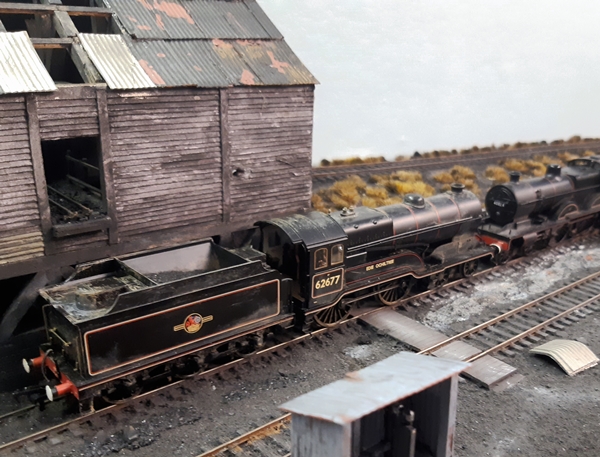 Auch
Ae is a 4mm scale Scottish Region locomotive
shed based in the 1960s. It is very much work in
progress but showing it in a part built state
gives the opportunity to see how a layout is
built. All the track work has been laid using
Peco code 75 track and wired for DCC operation.
Buildings on the layout are scratch built and
are based on prototypes in Scotland. The layout
will be operated with a mixture of steam and
diesel locomotives with many featuring working
sound.
Bazil Radford
- presented by
David Maries - 4mm Scale
 Bazil Radford station is the terminus station on a 12 miles single track branch line. The line leaves
the main line at Bazil Radford Junction and
terminates in the small market town of Bazil
Radford. The line was built by the Great Western
Railway and after nationalism and BR's regional
boundary changes it is now operated by a mix of
ex GWR/LMS and BR Standard Classes of motive
power. All the buildings have been scratch
built on this layout, with the track plan
promoting movement.
Bristol Avon Bridge
- presented by
Keith Sully - 4mm Scale
 Bristol Avon Bridge may remind you
of a certain large station in Bristol in an era
when the evenings and early hours of the morning
had a bustling newspaper, parcels and post
office traffic flowing to and from the South
West. The layout depicts platforms 3 and 5,
their avoiding lines and the Severn Beach bay to
the north and motorail terminal platform to the
south. Pause a while to watch long distance
trains change crew or loco. Regular HST services
mix with mk1 to mk3 regional services to
Weymouth, Fishguard, South Wales and beyond
Exeter. The station pilot fusses over motor rail
and parcels formations, while Speed-link
services for Severn Tunnel Jn and beyond arrive
in the avoiding lines. DCC control allows
flexibility to create a bustling, noisy,
environment. Signalling is automated, many
thanks to TrainTech for support in developing
this. The operating era spans almost 20 years,
liveries Blue through Intercity, sectorisation
and Rail Express Systems. The scene is
compressed, between the Post Office conveyor
bridge and the Bath Road Bridge, after crossing
the River Avon “cut”. The great trainshed is a
representation, hopefully capturing the essence
of Bristol as you view the coming and goings
from platform 3, the booking hall or the buffet!
The buildings and platform canopies have been an
experiment in laser cut components, supplied by
LCUT and bespoke structures created with help
from friends. The signal box is the guardian of
the old Bath Road locomotive depot, and the Post
Office conveyor buildings are both scratch built
from Photos. I hope you enjoy Bristol Avon
Bridge, “BABs”.
Dunwood Engine shed
- presented by
Rob Newman - 7mm Scale
The Dunwood Railway was
an industrial line built to convey timber
from the Dunwood Forest to processing plants
along the line, which had a connection to
British Railways. The line used a variety of
second hand rolling stock including steam
and diesel locomotives bought from other
industrial concerns. The locomotives were
serviced at Dunwood Engine Shed, which is
depicted on this layout. Situated within the
forest the shed provided basic facilities
accessed along a spur line off the main
running line. In operation the layout will
show the arrivals, movements and departures
within shed limits. The time is assumed to
be the late 1950s. It was time when some
industrial concerns were sometimes using
hired in locomotives from British Railways,
and at Dunwood Engine shed it may be
possible to see some small BR locomotives as
well as the resident fleet. Most of the
locomotives are kit built examples, with a
few detailed and weathered ready to run
engines where appropriate.
Henley In Arden
- presented by
Mike Bragg - 7mm Scale
 The Henley -In- Arden
Line, a twice -Derelict Railway and is here
a rebirth in Model Form. In 1861 a private
company was formed to build a railway from
Rowington Junction to Kingswood (now
Lapworth) to Henley-in-Arden a little over 3
miles. Five years later, when the line was
half made, funds ran short, and work on the
line was suspended. The line lay derelict
for twenty-eight years. Then came another
and larger scheme and the project
rejuvenated so work on the long-neglected
line was resumed in1889, and by 1894 the
line was ready for use. The G.W.R worked the
single line service from the very outset and
took it over in 1900. However, in 1914 the
passenger service was suspended although
goods continued to pass until 1916 when the
service was closed all together. During the
1980’s when I ran my small business in
Hatton, I not only saw remnants of the line
but, walked most of what was left before the
M40 wiped nearly all trace of the line. Well
as per usual I have massaged fact with more
than a soupcon of fiction and added a dash
of essence to create a might have been 1939
- 1950 version of the original. Adding at
least on the timetable station halts at
Rowington and Lowsonford The track layout is
similar as are the buildings although using
artistic licence the Station building is now
timber and not brick and I have moved Potato
Lane bridge to help conceal the fiddle yard.
Points are constructed from copper clad
sleepers to which the rail is soldered. but
the plain track is SMP. The power supply and
control are by DCC Power Cab, rolling stock
is mostly kit built but the locomotives are
proprietary models from Dapol. The Henley -In- Arden
Line, a twice -Derelict Railway and is here
a rebirth in Model Form. In 1861 a private
company was formed to build a railway from
Rowington Junction to Kingswood (now
Lapworth) to Henley-in-Arden a little over 3
miles. Five years later, when the line was
half made, funds ran short, and work on the
line was suspended. The line lay derelict
for twenty-eight years. Then came another
and larger scheme and the project
rejuvenated so work on the long-neglected
line was resumed in1889, and by 1894 the
line was ready for use. The G.W.R worked the
single line service from the very outset and
took it over in 1900. However, in 1914 the
passenger service was suspended although
goods continued to pass until 1916 when the
service was closed all together. During the
1980’s when I ran my small business in
Hatton, I not only saw remnants of the line
but, walked most of what was left before the
M40 wiped nearly all trace of the line. Well
as per usual I have massaged fact with more
than a soupcon of fiction and added a dash
of essence to create a might have been 1939
- 1950 version of the original. Adding at
least on the timetable station halts at
Rowington and Lowsonford The track layout is
similar as are the buildings although using
artistic licence the Station building is now
timber and not brick and I have moved Potato
Lane bridge to help conceal the fiddle yard.
Points are constructed from copper clad
sleepers to which the rail is soldered. but
the plain track is SMP. The power supply and
control are by DCC Power Cab, rolling stock
is mostly kit built but the locomotives are
proprietary models from Dapol.
Illie Town
- presented by
Keith & Aaron
Smith - 4mm Scale
 Illie
Town is a small modern image layout based in
Cheshire. Passenger services are operated by
Arriva Wales, East Midlands, Cross Country
and Northern. On the freight side, there's a
ballast siding and a warehouse that imports
steel, which are served by a variety of locos
from different companies. There's a two-road
loco depot with a separate fuelling point. The
layout is over 20 years old and has been on the
exhibition circle previously known as Bridge
Street, but a lot of work has gone into making
it Illie Town. Though the track plan is pretty
much the same, we added the bay platform,
fuelling point and warehouse for added interest,
along with new background scenery. Fully wired
for DCC and controlled by NCC power cab, all
turnouts and signals are analogue. With a daily
timetable of over 400 movements, there's always
something to watch.
Leigh St George
- presented by
Leigh Thompson - 2mm Scale
 Leigh
St George is a fictional market town, somewhere
in the Midlands. Set between 1990 & 1996, the
station comprises of two platforms and a small
station building. A TMD depot and fuelling point
is situated to the south of the layout operated
by BR Rail freight. Royal Mail occupies the
former British Rail goods siding and platform
for their mail & parcels trains. A stabling
point is situated to the west of the layout for
resting engines, and a type 15 signal box is
situated to the east of the layout, which was
saved from demolition by the local railway
enthusiasts club. At the back of the station is
a row of houses, known locally as “Railway
Terrace” and contains a fish & chip shop called
“The Cod father” and a pub called the “Lamb and
Flag”.
Oakenshaw
- presented by
Redditch MRC - 4mm Scale
 Oakenshaw
is a fictitious West Yorkshire mill town set in
the early 1960's located somewhere near to the
real town of Keighley on the Airedale line. Like
so many of the Yorkshire mill towns the layout
portrays a town in a valley centred around a
river crossing. Regional boundary changes in
1957 brought this former Midland Railway Station
into the short lived North Eastern Region of
British Railways. The station is very much based
on Midland Railway practice and the scale is 4mm
using "OO" gauge fine scale code 75 track. All
the buildings on the layout are scratch built,
mainly using thick card for the basic structure.
These were covered with plasticard to replicate
stone or brick finishes. The structures have
then been painted and weathered to represent the
prototypes from the area. The fiddle yard
features sixteen roads and is capable of holding
24 separate trains. All the buildings on the
layout are scratch built, mainly using thick
card for the basic structure. These were covered
with plastikard to represent stone or brick
finishes. Trains are made up of correctly trains
for the era and location that are hauled by a
mixture of steam and diesel locomotives.
Pirton and Wadborough
- presented by
PW Gang - 4mm Scale
 Pirton
Sidings was on the Birmingham to Gloucester
main line south of Worcester. The layout
features Pirton Signal box, level crossing
and sidings together with a model of the
former Wadborough station. The whole
catalyst for the layout was when Hornby
introduced what they call the Holy Trinity
Church model into their Skaledale range of
trackside model buildings. It appears to be
a pretty accurate replica of St. Peters
Church in Pirton, with its distinctive black
and white tower. The layout was then
constructed to showcase this model The
layout is exhibited by the PW Gang (Pirton
and Wadborough) and features trains that
would have operated on the line in the
1950's and 1960's.
Studley and Astwood Bank
- presented by
Steve Monk - 4mm Scale
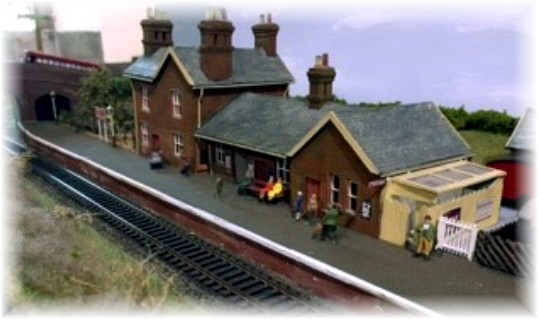 The station was three miles south
of the town of Redditch, on the line which left
the Birmingham to Gloucester main line at Barnt
Green and re-joined it again at Ashchurch near
Tewkesbury. The line ran through the towns of
Redditch and Evesham. At its beginning it was
operated by the Midland Railway until it became
part of the London Midland and Scottish Railway
in 1923. At nationalization in 1948 it was part
of the London Midland Region and, following
reorganization of the boundaries the Western
Region from 1958 until final closure on 6th July
1964. The station facilities comprised a yard
that could handle up to fifty-five wagons in its
heyday, a signal box, with a 16-lever frame and
goods shed with a single cart/lorry porch and
loading cane. There was also a cattle dock and
weigh bridge. In the yard there was space for
household coal and timber merchants, which
included T & M Dixon, The Alcester Co-Operative
Society and G. Shimpton. Some modeller’s
licence has been taken at the Redditch end of
the layout to give some additional points of
interest The station was three miles south
of the town of Redditch, on the line which left
the Birmingham to Gloucester main line at Barnt
Green and re-joined it again at Ashchurch near
Tewkesbury. The line ran through the towns of
Redditch and Evesham. At its beginning it was
operated by the Midland Railway until it became
part of the London Midland and Scottish Railway
in 1923. At nationalization in 1948 it was part
of the London Midland Region and, following
reorganization of the boundaries the Western
Region from 1958 until final closure on 6th July
1964. The station facilities comprised a yard
that could handle up to fifty-five wagons in its
heyday, a signal box, with a 16-lever frame and
goods shed with a single cart/lorry porch and
loading cane. There was also a cattle dock and
weigh bridge. In the yard there was space for
household coal and timber merchants, which
included T & M Dixon, The Alcester Co-Operative
Society and G. Shimpton. Some modeller’s
licence has been taken at the Redditch end of
the layout to give some additional points of
interest
Temple Bridge
- presented by
John Tisi - 4mm Scale
 Of the constituent companies of the Southern Railway the
London Brighton & South Coast Railway was the only one
not to cross the river Thames to have a terminus on the
north bank near to the lucrative City of London with its
growing commuter traffic, being content to terminate at
London Bridge. Temple Bridge is a model of a fictitious
station built by the LB&SCR to right this wrong,
modelled in the 1950 to 1960s BR(S) period. It is
located between Charring Cross and Blackfriars stations
in the Temple area of the Embankment, roughly where the
present-day Temple District line tube station is located
between Somerset House and the Inner Temple legal office
area. Temple Bridge station occupies the area between
The Strand at the eastern end of the Aldwych and
Victoria Embankment. The station fronts on to The Strand
and has been rebuilt by the Southern Railway in the
1930s in their concrete Art Deco style, the station
buildings and bridge over the Embankment were
reconstructed to modernise the station and of course the
signal box was replaced with a new concrete glass house
style box when the station was re-signalled with colour
light signalling. Below the signal box the Temple Bridge
tube station on the District line has been rebuilt in
the Charles Holden style of the 1930's The station
forecourt has a bus station as well as the normal drop
off and pickup facilities, railway offices, shops and
taxi rank. The station concourse has the remains of its
LB&SCR overall roof, now in the 1950's devoid of its
glass due to bomb damage during WW2 this gives our
passengers access to five platforms. Services are worked
by a variety of third rail EMU's ranging from the
converted steam stock 4SUB through the Southern Railway
2 HAL and BIL units to the latest BR 2 and 4 EPB's &
4CEP units. The river bridge is a 4 arch wrought iron
structure on granite piers carrying three tracks across
to the south bank at Southwark. Just off the South side
is a 2-road locomotive depot providing light servicing
and storage for the locomotives. The arches of the
curving viaduct are home to trades and businesses and
the river side is dominated by an LCC Council block of
flats in the typical hipped roof yellow brick style
common across central London from the 1920's. Of the constituent companies of the Southern Railway the
London Brighton & South Coast Railway was the only one
not to cross the river Thames to have a terminus on the
north bank near to the lucrative City of London with its
growing commuter traffic, being content to terminate at
London Bridge. Temple Bridge is a model of a fictitious
station built by the LB&SCR to right this wrong,
modelled in the 1950 to 1960s BR(S) period. It is
located between Charring Cross and Blackfriars stations
in the Temple area of the Embankment, roughly where the
present-day Temple District line tube station is located
between Somerset House and the Inner Temple legal office
area. Temple Bridge station occupies the area between
The Strand at the eastern end of the Aldwych and
Victoria Embankment. The station fronts on to The Strand
and has been rebuilt by the Southern Railway in the
1930s in their concrete Art Deco style, the station
buildings and bridge over the Embankment were
reconstructed to modernise the station and of course the
signal box was replaced with a new concrete glass house
style box when the station was re-signalled with colour
light signalling. Below the signal box the Temple Bridge
tube station on the District line has been rebuilt in
the Charles Holden style of the 1930's The station
forecourt has a bus station as well as the normal drop
off and pickup facilities, railway offices, shops and
taxi rank. The station concourse has the remains of its
LB&SCR overall roof, now in the 1950's devoid of its
glass due to bomb damage during WW2 this gives our
passengers access to five platforms. Services are worked
by a variety of third rail EMU's ranging from the
converted steam stock 4SUB through the Southern Railway
2 HAL and BIL units to the latest BR 2 and 4 EPB's &
4CEP units. The river bridge is a 4 arch wrought iron
structure on granite piers carrying three tracks across
to the south bank at Southwark. Just off the South side
is a 2-road locomotive depot providing light servicing
and storage for the locomotives. The arches of the
curving viaduct are home to trades and businesses and
the river side is dominated by an LCC Council block of
flats in the typical hipped roof yellow brick style
common across central London from the 1920's.
Todmolden Midland
- presented by
Ed Purcell - 2mm Scale
 Todmolden Midland is a former Midland
Railway terminus 48 by 14 inches with a
2-foot cassette fiddle yard. This is small
even for N gauge, but the scenic section
includes station, goods shed, coal yard,
loco shed, canal scene, a couple of West
Yorkshire mills, a pub, and distant views of
hills. Motive power is former Midland
Railway and London Midland Scottish Railway
along with some BR Standards, some visiting
ex LNER locos on summer holiday trains and
even one or two diesels and DMUs. Rumour has
it that Holbeck has occasionally sent a
Jubilee or a Scot on a summer special. Track
is PECO with SEEP operated points; control
is analogue via an excellent controller
designed and built by Warley Model Railway
Club members. Stock is by Graham Farish,
Dapol, Peco, N gauge society, Union Mills,
and some kit-built items. Scenery uses
various products including the excellent
(and rare) Graham Avis trees. Buildings are
mainly scratch built with a couple of
modified kits. PECO N gauge stone building
sheets have proved very effective. However,
the church is made from OO Wills sheet! Some
buildings are scratch built Settle and
Carlisle designs which are justified by the
line’s presumed historic origins. Mill
buildings and pub are scratch built, based
on types of building found in the area. The
backscene uses acrylics. Todmolden Midland is a former Midland
Railway terminus 48 by 14 inches with a
2-foot cassette fiddle yard. This is small
even for N gauge, but the scenic section
includes station, goods shed, coal yard,
loco shed, canal scene, a couple of West
Yorkshire mills, a pub, and distant views of
hills. Motive power is former Midland
Railway and London Midland Scottish Railway
along with some BR Standards, some visiting
ex LNER locos on summer holiday trains and
even one or two diesels and DMUs. Rumour has
it that Holbeck has occasionally sent a
Jubilee or a Scot on a summer special. Track
is PECO with SEEP operated points; control
is analogue via an excellent controller
designed and built by Warley Model Railway
Club members. Stock is by Graham Farish,
Dapol, Peco, N gauge society, Union Mills,
and some kit-built items. Scenery uses
various products including the excellent
(and rare) Graham Avis trees. Buildings are
mainly scratch built with a couple of
modified kits. PECO N gauge stone building
sheets have proved very effective. However,
the church is made from OO Wills sheet! Some
buildings are scratch built Settle and
Carlisle designs which are justified by the
line’s presumed historic origins. Mill
buildings and pub are scratch built, based
on types of building found in the area. The
backscene uses acrylics.
Two Locks
- presented by
Nigel Harrod - 2mm Scale
Two Locks is an N Gauge layout with
the canal at the forefront, with two locks
rising to the canal basin. Running behind the
canal is the railway with local station and
town. The station having a platform each for the
up and down line and the third bay platform for
local DMU services. The trains are operated
using DCC operation and because the layout is
not set in any particular era, it can operate
using stock from any of the follow three eras of
1960s steam or diesel, British Rail blue or the
present day.
Torcy (SNCF)
- presented by
John Smith - 3.5mm Scale
 Torcy is located in the Department of
Seine - Maritime in the Haute Normandie.
(upper Normandy), Region of Northern France
at the end of a single-track branch of the
line from Rouen to Dieppe. Torcy is a real
place, but the railway is completely
fictitious. The survival of the imaginary
branch line is due, in the main, to a
distribution depot set up to transfer goods
arriving by rail to road vehicles for
delivery to this area of Northern France,
the level of freight traffic is sufficiently
healthy to require several trains a day. In
addition, loaded trains of open wagons
containing gravel from a quarry up the line,
that only has access from the Torcy
direction, enter the station area to reverse
before departing to Soteville yard in Rouen
for onward dispatch. The station also
survives and is served by a regular
passenger service from Rouen operated by
diesel powered push-pull trains and multiple
units. There is a twice daily through train
to/ from Paris and occasional steam hauled
specials. The period modelled is in the era
between 2005 and 2008 and the railway is
controlled by a Lenz DCC system.
|

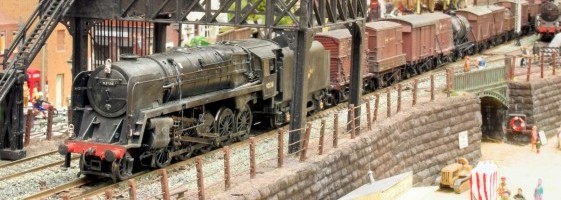

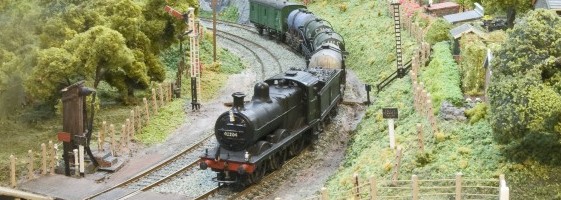
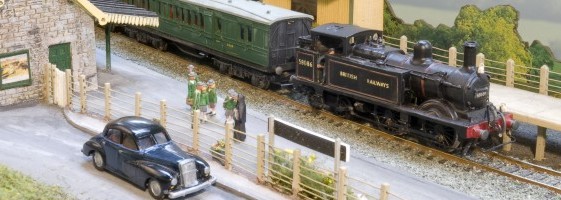

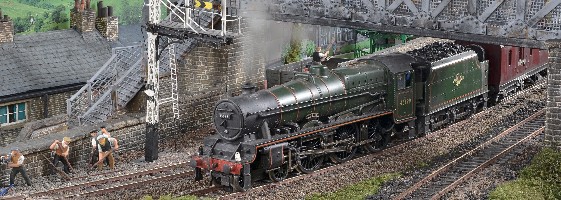
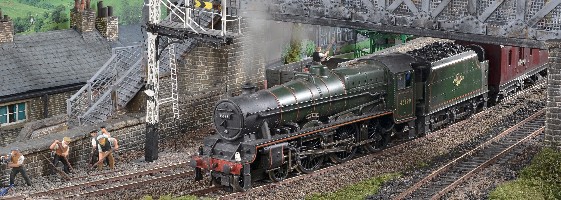








 The station was three miles south
of the town of Redditch, on the line which left
the Birmingham to Gloucester main line at Barnt
Green and re-joined it again at Ashchurch near
Tewkesbury. The line ran through the towns of
Redditch and Evesham. At its beginning it was
operated by the Midland Railway until it became
part of the London Midland and Scottish Railway
in 1923. At nationalization in 1948 it was part
of the London Midland Region and, following
reorganization of the boundaries the Western
Region from 1958 until final closure on 6th July
1964. The station facilities comprised a yard
that could handle up to fifty-five wagons in its
heyday, a signal box, with a 16-lever frame and
goods shed with a single cart/lorry porch and
loading cane. There was also a cattle dock and
weigh bridge. In the yard there was space for
household coal and timber merchants, which
included T & M Dixon, The Alcester Co-Operative
Society and G. Shimpton. Some modeller’s
licence has been taken at the Redditch end of
the layout to give some additional points of
interest
The station was three miles south
of the town of Redditch, on the line which left
the Birmingham to Gloucester main line at Barnt
Green and re-joined it again at Ashchurch near
Tewkesbury. The line ran through the towns of
Redditch and Evesham. At its beginning it was
operated by the Midland Railway until it became
part of the London Midland and Scottish Railway
in 1923. At nationalization in 1948 it was part
of the London Midland Region and, following
reorganization of the boundaries the Western
Region from 1958 until final closure on 6th July
1964. The station facilities comprised a yard
that could handle up to fifty-five wagons in its
heyday, a signal box, with a 16-lever frame and
goods shed with a single cart/lorry porch and
loading cane. There was also a cattle dock and
weigh bridge. In the yard there was space for
household coal and timber merchants, which
included T & M Dixon, The Alcester Co-Operative
Society and G. Shimpton. Some modeller’s
licence has been taken at the Redditch end of
the layout to give some additional points of
interest